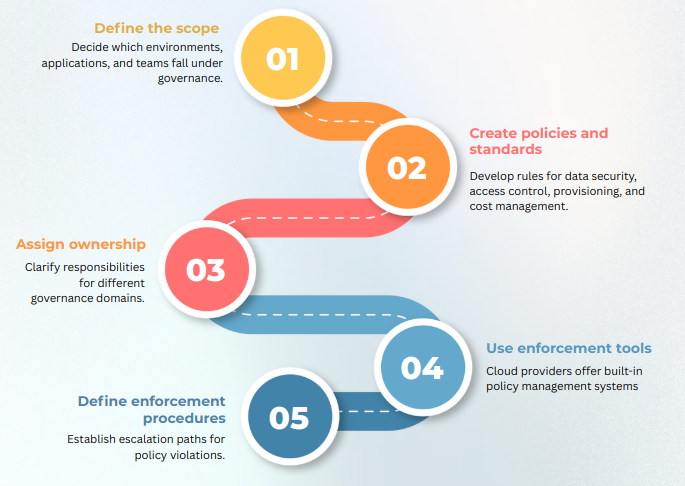Align your cloud with business goals while keeping costs and risks in check with the right Cloud Governance Strategies via our Cloud Management Team.
Cloud adoption has been going strong in industries ever since its inception. Organizations of every size now rely on public, private, and hybrid cloud solutions to power critical applications, store vast amounts of data, and support distributed teams. With this growing reliance comes the challenge of maintaining control, security, and cost efficiency. This is where cloud governance frameworks step in.
Cloud governance ensures that cloud resources are used responsibly, securely, and in line with business goals. Furthermore, it provides structure in an environment that could otherwise become chaotic, helping teams balance flexibility with accountability. Today, we will explore what cloud governance is, why it matters, the principles behind it, and how to build an effective framework for long-term success.
Overview
What is Cloud Governance?
At its core, cloud governance is a set of policies, responsibilities, and processes that direct how an organization manages its cloud resources. Think of it as a blueprint that ensures your teams use the cloud in a way that is safe, cost-effective, and compliant with regulations.
A governance model covers several areas, including identity and access management, resource deployment, security monitoring, and cost control. For instance, an organization might require that every virtual machine be tagged with the department that owns it or that workloads only run in approved geographic regions. These rules help avoid risks like overspending, data breaches, or regulatory violations.
The main challenge lies in implementation. Many organizations already have large, distributed cloud footprints. Integrating a governance framework into existing operations can feel disruptive, especially if teams are used to operating independently. Without governance, the risks multiply, and costs can quickly spiral.
Core Pillars of a Cloud Governance Framework
A complete cloud governance model usually addresses five central areas. Together, these principles give organizations a way to maintain security, stability, and financial control.
1. Data Security
Policies around data security ensure that sensitive information is shielded against unauthorized access. Encryption, access controls, and compliance checks are all critical. For example, governance might mandate encryption for all data at rest and in transit, or require approval before storing data in certain locations due to legal restrictions.
2. Threat Detection
Cloud environments are dynamic, which means threats can appear suddenly. Real-time monitoring tools play an essential role in identifying misconfigurations, outdated software, or suspicious behavior. Governance ensures these tools are deployed and alerts are acted upon promptly.
3. Risk Management
Risk management policies define how organizations identify, assess, and prioritize threats. This could include automatically classifying risks by severity and providing clear procedures for remediation. Hence, the objective is to make informed decisions without wasting time or resources.
4. Cost Management
As cloud resources are provisioned instantly, costs can escalate just as quickly. Governance introduces mechanisms to track spending, flag unused resources, and prevent waste. Some organizations even set automated rules to shut down idle instances.
5. Change Management
Without rules around change, cloud environments can drift into chaos. Governance establishes how updates are requested, approved, and implemented. This reduces unauthorized modifications and ensures changes are properly logged for audits.
Benefits of Cloud Governance
Cloud governance is more than a set of guardrails. It is a driver of stability, security, and cost control. Here are some of the major benefits:
- Governance enforces observability, which means every system and process can be monitored effectively. This improves troubleshooting and helps maintain consistent performance.
- Policies around authentication, data access, and runtime behavior create layers of protection. Automated responses to security incidents can contain issues before they cause widespread damage.
- Furthermore, standardizing resource allocation ensures that no team overcommits or leaves assets idle.
- Organizations often use services across AWS, Azure, Google Cloud, and other platforms. Governance makes it possible to apply the same policies across all of them, reducing management complexity.
Industries such as healthcare and finance face strict regulatory requirements. Also, governance ensures compliance through defined processes, consistent monitoring, and detailed reporting.
How to Build an Effective Cloud Governance Framework
Building governance is a journey. These five steps provide a practical roadmap:

Established Cloud Governance Models
Several well-recognized frameworks guide how to design governance strategies:
- COBIT
Created by ISACA, COBIT offers detailed processes for IT governance. The latest version, COBIT 2019, includes design factors, maturity models, and compliance certifications.
- ITIL
ITIL focuses on aligning IT services with business needs. The ITIL 4 version includes practices for cloud governance, emphasizing strategy, policy enforcement, and continual improvement.
- ISO/IEC 38500 & ISO/IEC 27017
These international standards provide guidelines for IT governance and cloud security. They ensure alignment with business objectives while setting out security practices for providers and customers.
Organizations can adopt one of these models directly or adapt elements to their unique requirements.
[Need assistance with a different issue? Our team is available 24/7.]
Conclusion
In short, Cloud governance strategies are about ensuring that the cloud works for your business instead of against it. By setting clear policies, monitoring usage, and holding teams accountable, you can unlock the full value of cloud technology while keeping risks under control.







0 Comments